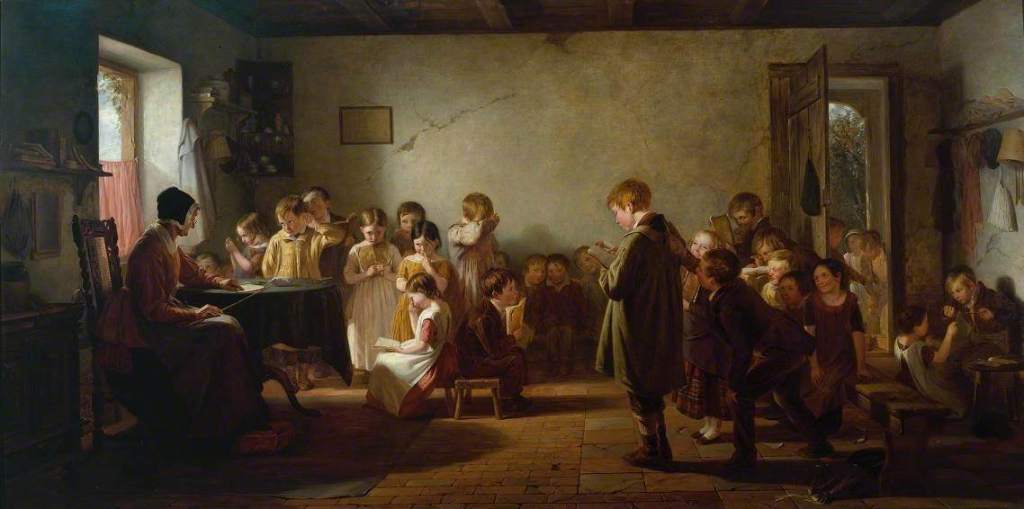Samuel Johnson was born in September 1709 on Breadmarket Street in Lichfield. His home provided his first school, at “his mother’s knee.” Sarah Johnson taught her son to read. Samuel recalls that she also taught him about “the future state” where there were two places, “one a fine place filled with happiness called Heaven and the other a sad place called Hell”. Johnson would have been about three at the time.
Growing up in a bookshop, Johnson was surrounded by literature and opportunities to learn.
At four years old Johnson went to a Dame school, around the corner from his home in Dam Street. The school was run by Ann Oliver.

Dame Schools were small and informal, privately run, classrooms. At this time there was no compulsory education and the number of children receiving any formal kind of education was limited. The aristocratic and wealthy were taught at home by tutors and governesses. The Public Schools, old foundations dating back to the middle-ages, were too expensive for most people. For children from seven onwards fee-paying grammar schools might have been available, founded by public spirited people such as wealthy merchants. Run as businesses, these schools were dependent on the fees and their power to attract customers so did not always survive long. There were also Charity Schools. In 1699 the Society for the propagation of Christian Knowledge was founded. Its stated aim was to bring the knowledge of Christianity to the people, to which end it founded schools for poor children from ages of 7-11. These schools provided a basic Christian education and trained teachers for the job. As a member of the middling-classes, the son of traders, Johnson attended Dame Schools and Grammar Schools.

Johnson’s own writings about his Dame school days did not survive, but he recalls in conversation with Boswell that Oliver could read the ‘Black Letter’, an antiquated style of typography generally used in Germanic texts, often on ecclesiastical subjects. He also remembers being given a present of gingerbread by Ann Oliver when he eventually left Lichfield to go up to Oxford University, and was told he was “the best scholar she ever had”
Johnson attended two Dame schools, the other when he was about six years old which was run by a Tom Browne. Browne was a shoemaker who supplemented his earnings running a school. Johnson recalls that Browne also published a spelling book.
Around January 1717 Johnson entered Lichfield Grammar School. It was at Lichfield Grammar School that Johnson’s excellent knowledge of Latin was developed. He learned first under Hawkins, undermaster of the school, for two years and was then taught by John Hunter, head-master and father of the Poet Anna Seward. Hunter was described by Johnson as “very severe, and wrong-headedly severe”, but Johnson did later attribute his accuracy in Latin to Hunter’s strict methods.

Johnson’s annals provide a wealth of detail about his time at the school. There were eleven students in the class. In the under-school, Aesop’s Fables were learned by heart on a Thursday night and repeated on a Friday morning. Examinations took place on Saturday mornings. Texts were almost exclusively in Latin. Books consulted included Lily’s Grammar, which had been a significant source for Shakespeare. Johnson found examinations easy, and remembered school “with pleasure.”

Johnson’s school-friend Edmund described his years of learning beside Samuel to James Boswell. Hector remembered that he “never knew him corrected at school, but for talking and diverting other boys from their business.” He was an intuitive learner but his life-long tendency for idleness and procrastination were apparent as a child, however “whenever he made an exertion he did more than anyone else.” Samuel had an extraordinary memory: Hector recalls reciting 18 verses of a poem to him, which he repeated back exactly.
Due to Johnson’s poor eyesight, he did not join in the play of the other children apart from during the winter when he enjoyed being pulled around on the ice. He was also often carried from home to school by three of his school friends.

Johnson attended two Grammar Schools. In 1726 he enrolled at Stourbridge Grammar School while staying with his uncle, Cornelius Ford. Johnson’s education in Lichfield had already given him such a good grounding that he acted as an assistant to master Mr Wentworth and helped to teach younger boys.


Johnson said of his two schools: “At one, I learnt much from the school, but little from the master; in the other, I learnt much from the master, but little in the school”.
He reflects more broadly on the passing of school days:
“The time… appeared much longer by the multitude of novelties that it supplied, and of incidents, then in my thoughts important, it produced. Perhaps it is not possible that any other period can make the same impression on the memory”
Samuel Johnson
January 24th marks the International Day of Education, a United Nations day of observance which celebrates education and draws attention to the importance of inclusive and equitable education and lifelong opportunities for all. Find out more at: https://www.un.org/en/observances/education-day.
Many thanks to Annemarie Powell, Birthplace Volunteer and inspiring educator, for her work on this blog post.
